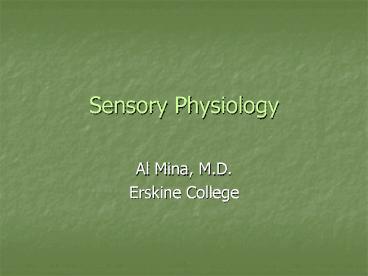Sensory Physiology - PowerPoint PPT Presentation
1 / 26
Title:
Sensory Physiology
Description:
Sensation information reaches consciousness. Perception info understood and has meaning ... specific locations (somatosensory cortex, visual, auditory, etc. ... – PowerPoint PPT presentation
Number of Views:45
Avg rating:3.0/5.0
Title: Sensory Physiology
1
Sensory Physiology
- Al Mina, M.D.
- Erskine College
2
Sensory information
- Anything that is picked up and processed by a
sensory system - Sensation information reaches consciousness
- Perception info understood and has meaning
3
Receptors
- Transform stimuli into graded potentials
- Either ending of axon, or separate cells
- Sensory transduction change stimulus to signal
- Highly tuned to specific stimulus, but can be
activated by others if stimulus strong enough
however, signal will be same
4
Receptor classes
- Mechanoreceptors pressure/stretch
- Thermoreceptors temp
- Photoreceptors light
- Chemoreceptors substances
- Nociceptors - pain
5
Signal tranduction
- Starts with ion channels open when stimulated
(directly or 2nd messenger) - Creates graded potential receptor potential
- Current flows to area with voltage gated channels
- Action potential can then be generated
6
Signal strength
- Each action potential is all or none, but
frequency of APs is influenced by graded
potential magnitude - Magnitude influenced by
- Stimulus strength
- Summation
- Rate of change in strength
- May also be influenced by adaptation
7
Coding
- Transferring stimulus into signal
- Begins at receptor sites (receptor field)
- Influenced by type, intensity, and location of
stimulus - Receptor fields of different sensory units
usually overlap
8
Stimulus type
- Modality what kind of stimulus
- All receptors of a single axon sensitive to same
type, but may overlap with fields of different
types
9
Stimulus intensity
- Increased intensity increased receptor
potential - Also increased signal will affect adjacent
branches, increasing summation affect, which
increases AP frequency - Recruitment other sensory units involved
10
Location
- Labeled lines specific pathway traveled by AP
from a receptor - Precision influenced by size, density, and
overlap of sensory units in area. - More receptors greater precision.
- Smaller receptive field greater precision
11
Lateral inhibition
- Further enhances ability to locate
- Strongest signals will use inhibitory neurons to
dampen the response in surrounding neurons - Not all pathways use equally
- Prominent in retina, pressure
- Less relevant in temperature/pain
12
Duration
- Reaction to constant stimulus
- Adaptation stopping or decreasing signal in
spite of constant stimulus
13
Neural pathways
- Ascending pathways bundles of chains of sensory
pathways. - Run parallel to each other, deliver information
to specific location on cerebral cortex
14
Ascending
- Usually carry same type of information (specific
ascending pathways) - Synapse in CNS two or more times
- Cross from one side of body to opposite cortex
specific locations (somatosensory cortex, visual,
auditory, etc.) - Signal then goes to cortical association areas
for further processing and integration
15
Nonspecific pathways
- May send multiple types of signals
- Usually signal ends in brainstem or thalamus
- Nonspecific, but signals help in alertness
16
Processing of perceptions
- Association areas are outside sensory areas
- Integrate multiple stimuli
- Also add input from learning, memory, emotion
17
Influences on perception
- Adaptation
- Emotion, memory, experience, etc.
- Preventing overload
- Inability to receive stimulus (infrared)
- Damaged neural networks
- Chemical/disease altering perceptions
18
Somatic sensation
- Receptors respond to variety of stimuli
- Sense temperature, pressure, vibration, position,
touch, pain - Visceral sensations use same type of receptors
19
Touch, pressure
- Mechanoreceptors nerve endings linked to
collagen fibers and encapsulated - Fibers transmit stimulus to ion channels,
activate - Variable adaptation rates
- Sensitivity varies
20
Posture, movement
- Muscle-spindle stretch receptors
- Mechanoreceptors
- Respond to rate and magnitude of stretch
- Assisted by vision, balance organs
21
Temperature
- Separate cold and warm thermoreceptors
- Open nonselective cation channels at certain
temperatures - Also respond to certain chemicals (ethanol,
menthol)
22
pain
- Nociceptors free nerve endings
- Respond to deformity, heat, chemicals (typically
those released by damaged cells) - On synapsing with interneurons, may induce
referred pain, especially from visceral organs
23
Contd
- After stimulus, may get increased or decreased
sensitivity to signal - Hyperalgesia increased pain after signal
- May be influenced by emotions, past experience
24
- Analgesia reduction of pain stimulus
- Suppression by higher cortical function down
descending pathway - Also release endogenous opioids
- Can be stimulated with accupuncture
- Stimulation of local touch receptors can also
inhibit pain receptors
25
Pathways
- Anterolateral pathway conduit for pain and
temperature - Crosses in spinal cord
- Dorsal column pathway conduit for touch,
pressure, proprioception - Crosses in brainstem
- Both synapse in thalamus, then in somatosensory
cortex
26
Somatosensory cortex
- Receptors go to specific areas on cortex
- Common areas grouped together
- Highest density areas have larger areas
- Homunculus
- Can modify in case of injury































